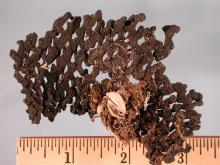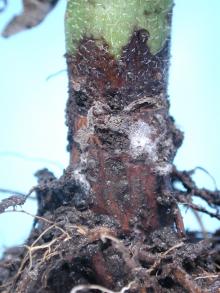Cause The fungus Sclerotinia sclerotiorum overwinters as black sclerotia in soil, among seeds, and in plant debris for 3 to 7 years. Dry, cool soil conditions favor survival of sclerotia. Sclerotia germinate and infect adjacent roots unless they are buried too deeply. The fungus also can spread from plant to plant by root contact. Sclerotia may also germinate to form small mushrooms (apothecia) that produce a sexual spore stage (ascospores), which are blown by wind and can infect flowers or stems. Head rot reduces seed quality and lead to rancidity. The disease is most severe in rainy or humid weather during or shortly after flowering. The fungus has a large host range of more than 360 plant species in 225 genera in 64 families.
Symptoms Plants suddenly wilt after warm, dry periods in early summer. Upper leaves droop; in a few days all leaves droop, and the plant dies. Plants may also bend over or break. Young plants turn black; older plants remain tan. A canker at the base of the stem extends several inches above the soil line. Cankers are soft, water soaked, and gray to brown. Dense, white mold grows on the canker surface. Large, black, irregularly shaped sclerotia are in the moldy growth or stem.
Flowers may develop a small soft, water-soaked spot that rapidly dries out and becomes pinkish. A white, cotton-like mold may grow over the diseased area. The flower head may rot partially or completely. Seed hulls may discolor. Some sclerotia develop below the seed layer; others form around seeds.
Cultural control
- Rotate with nonhost crops such as monocots (cereals and grasses).
- Plant healthy seed that is free of sclerotia.
- Deeply plow or bury residue.
Biological control
- Bexfond at 7 to 14 fl oz/A. 4-hr reentry. O
- Contans WG at 1 to 2 lb/A in as a preplant or postharvest treatment. Incorporate thoroughly in the top 2 inches of soil. Limited studies in snap bean in the Pacific Northwest and elsewhere has shown that protective fungicides are still required because only a few sclerotia are required to cause severe epidemics in a field. 4-hr reentry. O
Reference Gulya, T., Harveson, R., Mathew, F., Block, C., Thompson, S., Kandel, H., Berglund, D., Sandbakken, J., Kleingartner, L., and Markell, S. 2019. Comprehensive disease survey of US sunflower: Disease trends, research priorities and unanticipated impacts. Plant Disease 103:601-618.



